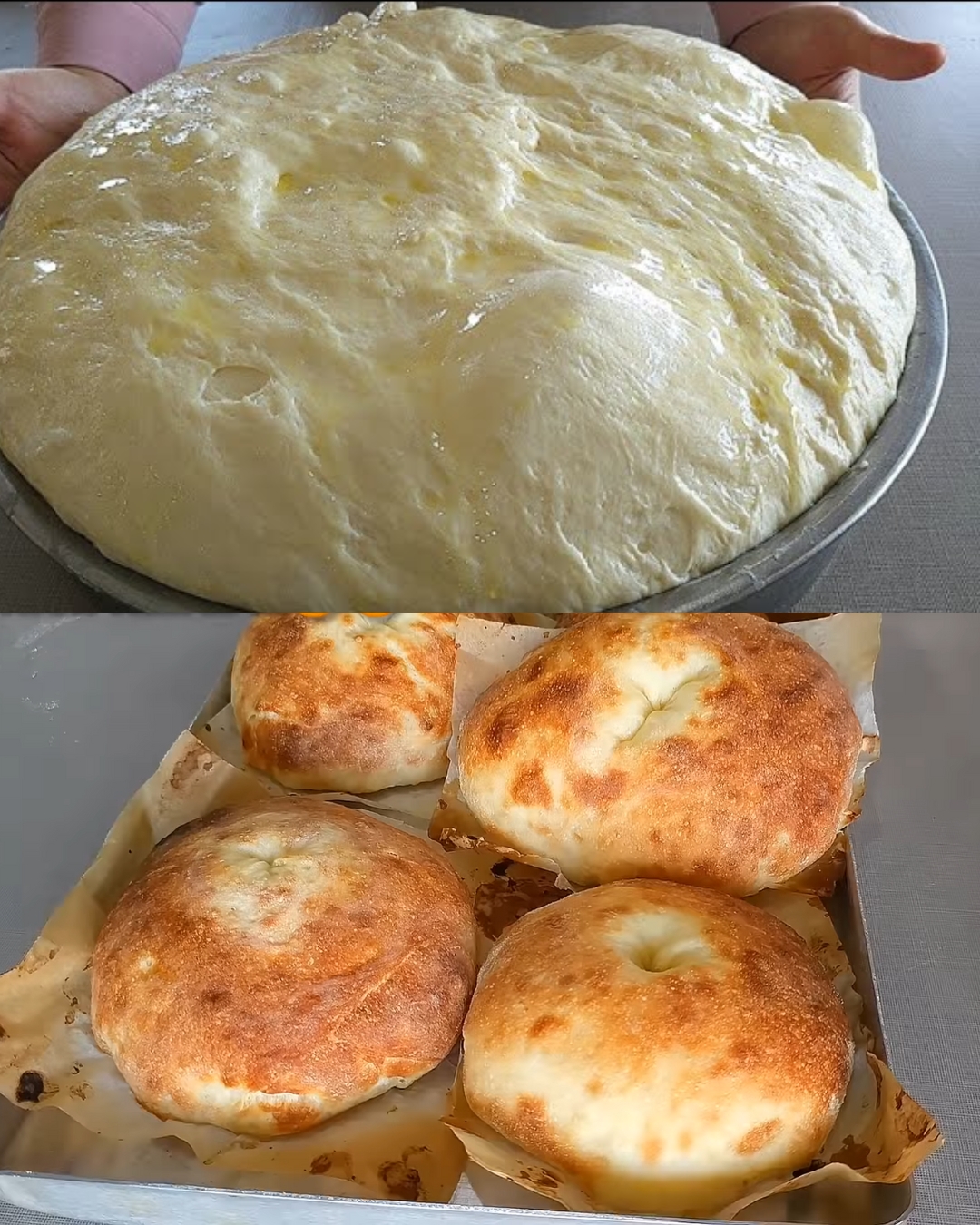This recipe for Authentic Turkish Fat Bread (also called “Yağlı Ekmek” or “Bazlama-Style Bread”) is more than just a simple homemade loaf—it’s a deeply traditional, soft, and chewy bread that’s been cherished in Turkish homes for generations. Its pillowy texture, golden exterior, and slightly tangy flavor from long fermentation make it the ultimate choice for everything from breakfast spreads to sandwich bases. What makes this version special is its unique hydration process, use of olive oil during the folding stages, and the signature sauce applied before baking that gives it a rustic, artisan finish.
Ideal for bakers of all levels, this bread is incredibly rewarding to make. The process, while hands-on, is meditative and yields bakery-quality results in your own kitchen. Whether enjoyed warm from the oven, stored for meal prep, or frozen for future use, this Turkish-style fat bread is soft, flavorful, and beautifully authentic.
Cooking Time
-
Preparation Time: 1 hour 30 minutes (including kneading and shaping)
-
Fermentation Time: 1 hour 30 minutes total
-
Baking Time: 7 minutes per batch
-
Total Time: Approx. 3 hours 15 minutes
Ingredients
For the Dough:
-
All-purpose flour: 10 cups (approx. 1300 g)
-
Salt: 1 tablespoon
-
Warm water: 800 ml
-
Dry yeast: 10 g (about 1 tablespoon)
-
Sugar: 3 tablespoons
For the Folding and Handling:
-
Water (for wetting hands)
-
Olive oil (for gas removal and moisture)
For the Topping Sauce:
-
Flour: 1 tablespoon
-
Hot water: ½ cup
-
Warm water: ½ cup
Additional:
-
Cornmeal or semolina (for dusting baking paper)
-
Baking paper
-
Optional: extra flour for dusting
Step-by-step Cooking Directions
Step 1: Prepare the Yeast Water
In a mixing bowl or jug, combine 800 ml of warm water with 10 g dry yeast and 3 tablespoons sugar. Stir until dissolved and let it activate for a few minutes.
Step 2: Mix the Dough
Place 10 cups (1300 g) of flour in a large bowl. Add 1 tablespoon salt and pour in the yeast mixture. Begin mixing by hand, dipping your hand in water as needed to prevent sticking. Continue until a rough dough forms.
Step 3: Initial Kneading
Knead the dough with wet hands. If the dough is too sticky, dip your hand in water repeatedly rather than adding more flour. After 5–7 minutes of kneading, gather the dough into a ball and let it rest, covered, for 10 minutes.
Step 4: Folding and Resting
Fold the dough inward from the edges toward the center, wetting your hands as you go. Let it rest again, this time for 20 minutes.
Step 5: Olive Oil Stage
After the second rest, use olive oil on your hands and lightly press down to release gas from the dough. This adds flavor and helps develop the structure. Cover and let rise for 1 hour until doubled.
Step 6: Shaping the Dough
Transfer the dough onto a floured surface and gently deflate. Divide into 9 equal portions. Shape each into round balls. Cover and let them rest for 5 minutes.
Step 7: Prepare the Sauce
In a small bowl, mix 1 tablespoon flour, ½ cup hot water, and ½ cup warm water until smooth. This creates a silky, sticky glaze for the bread.
Step 8: Final Shaping and Topping
Flatten each dough ball gently. Place on a baking paper sprinkled with cornmeal or semolina. Dip your fingers in the prepared sauce and press down in the center of each bread to create a rustic indentation. Brush or spoon the remaining sauce generously over each bread.
Step 9: Bake
Preheat your oven to 250°C (482°F), preferably on fan mode. Flip a baking tray upside down, preheat it in the oven, and carefully place the breads (with baking paper) on it. Bake for 6–7 minutes or until puffed and golden brown.
Step 10: Cool and Serve
Remove from the oven and cool on a wire rack. Serve warm or store in an airtight container.
Nutritional Information
(Per bread, based on 9 servings)
-
Calories: 280
-
Carbohydrates: 55 g
-
Protein: 7 g
-
Fat: 3 g
-
Sodium: 370 mg
-
Fiber: 2 g
The Origins and Popularity of the Recipe
Fat bread (Yağlı Ekmek) has deep roots in Turkish culinary history. Originating from Anatolian villages, this bread was traditionally baked on stone griddles or in wood-fired ovens. It’s particularly popular in home-style breakfasts and rural feasts. Its popularity today extends beyond Turkey as home bakers across the globe are turning to slow-fermented, rustic breads for both health and flavor. With the rise of artisanal baking, the demand for naturally proofed, crusty-yet-soft loaves like this one is soaring.
Reasons Why You’ll Love the Recipe
-
Super soft interior with a light crust
-
Fermented flavor that develops over time
-
Versatile: great for breakfast, sandwiches, or soups
-
Easy to make in large batches and freeze
-
Uses pantry staples—no fancy equipment needed
Health Benefits
-
Made with simple, natural ingredients
-
No preservatives or additives
-
Yeast fermentation improves digestibility and increases certain nutrients
-
Lower fat than many commercial breads
-
Great alternative to store-bought loaves with added sugars and oils
Serving Suggestions
-
Serve warm with butter and jam for breakfast
-
Use as a base for Turkish pide or flatbread pizza
-
Pair with lentil soup or yogurt-based soups
-
Slice horizontally for sandwiches
-
Enjoy with olive oil and za’atar for dipping
Common Mistakes to Avoid
-
Using too much flour during kneading: stick to water-dipped hands to avoid a dense dough
-
Skipping rest periods: each fermentation helps develop flavor and structure
-
Underbaking: ensure oven is fully preheated for the perfect puff
-
Overworking the dough before shaping: handle gently to retain air pockets
-
Using cold water for the sauce: hot water gives it the right texture
Pairing Recommendations
-
Drinks: Ayran (Turkish yogurt drink), Turkish tea, or mint lemonade
-
Main dishes: Shakshuka, grilled meats, or stuffed vegetables
-
Sides: Cacık (Turkish cucumber yogurt dip), hummus, baba ghanoush
-
Cheeses: Feta, labneh, or goat cheese with olive oil
Cooking Tips
-
Wet hands are key to a manageable dough
-
A well-proofed dough will be airy and light—don’t rush it
-
Try adding nigella seeds or sesame on top for extra aroma
-
Store in a cloth-lined basket to maintain softness after baking
-
Freeze once cooled and reheat in oven at 180°C for 5–8 minutes
Similar Recipes to Try
-
Turkish Bazlama (Pan-Cooked Flatbread)
-
Pita Bread with Steam-Puff Technique
-
Rustic Sourdough Loaf
-
Lavash (Soft Wrap Bread)
-
Naan with Yogurt and Butter
Variations to Try
-
Whole wheat version: Replace 1/3 of the flour with whole wheat
-
Herbed variation: Add thyme or rosemary to the dough
-
Spicy version: Mix chili flakes into the topping sauce
-
Stuffed version: Fill with cheese or spinach before shaping
-
Mini breads: Divide dough into 12–14 smaller rounds for snack-sized breads
Ingredient Spotlight
Flour
All-purpose flour is ideal here for its balance of protein and softness. You can use bread flour for chewier results, or mix in semolina for added texture.
Yeast
Active dry yeast ensures even fermentation. Combined with sugar and warm water, it activates quickly and gives the dough a beautiful rise.
Olive Oil
A key component for moisture and handling, olive oil also adds flavor and aids in shaping the dough without sticking.
Cornmeal
Used to dust the baking paper, it creates a crispy bottom and prevents sticking.
Flour-Water Sauce
This unique topping helps seal moisture and gives the bread its signature golden, rustic look. It also allows any seeds or herbs to stick better.
Conclusion Paragraph
Homemade bread doesn’t get much better than this Authentic Turkish Fat Bread. With a soft crumb, subtle fermented aroma, and versatile flavor, it’s perfect for everyday meals and special occasions alike. The hands-on process—kneading with wet hands, folding with olive oil, and finishing with a flour-water glaze—may seem unusual at first, but it’s exactly what gives this bread its signature character. Whether served warm, frozen for later, or used as the base for countless dishes, this is a recipe that delivers on flavor, texture, and tradition.
10 Comprehensive Frequently Asked Questions
1. Can I make this bread with whole wheat flour?
Yes, but it will be denser. For best results, mix whole wheat with all-purpose flour in a 1:2 ratio.
2. Can I use instant yeast instead of dry yeast?
Absolutely. Use the same amount, and you can skip the dissolving step—just mix it into the flour.
3. Why is my dough too sticky?
The dough is meant to be moist. Use water-dipped hands for kneading instead of adding flour.
4. How long can I store this bread?
Keep it at room temperature in an airtight container for 2–3 days, or freeze for up to 2 months.
5. Can I add toppings like sesame or nigella seeds?
Yes! Sprinkle them over the bread after applying the sauce.
Advertisement
6. What’s the purpose of the flour-water topping?
It creates a rustic crust, retains moisture, and gives the bread its characteristic finish.
7. Can I make the dough in advance?
Yes. After the final rise, refrigerate overnight and bake the next day.
8. Why is my bread not puffing in the oven?
Ensure your oven is fully preheated to 250°C. Use fan mode if available.
9. Can I use a pizza stone instead of an upside-down baking tray?
Yes, a pizza stone is ideal for heat retention and perfect bottoms.
10. Is this bread suitable for sandwiches?
Absolutely. Slice horizontally and fill with cheese, meats, or veggies. It’s soft yet sturdy.

